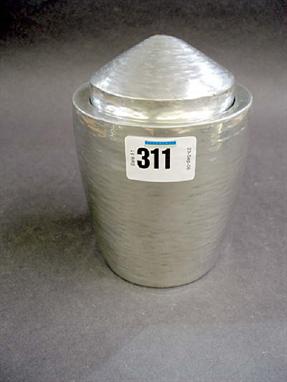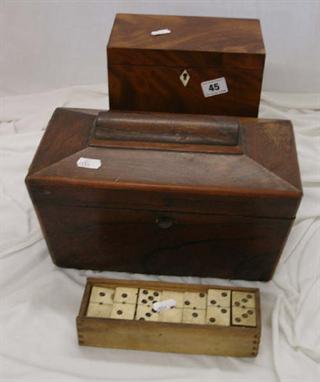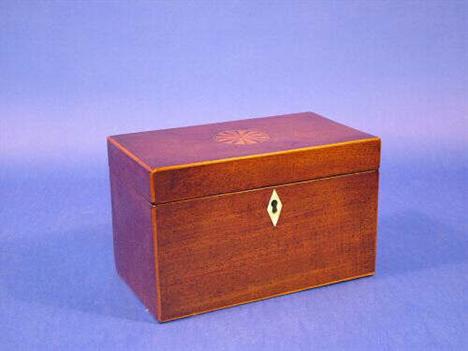An early 19th Century tortoiseshell, pewter strung and mother of pearl inlaid tea caddy of serpentine form, the hinged lid revealing twin shaped lidded compartment, each with floral mother of pearl finials above floral inlaid front, stepped base, and raised on four brass ball feet, 14.5 cm x 20 cm x 13 cm (ILLUSTRATED)
81699 Preisdatenbank Los(e) gefunden, die Ihrer Suche entsprechen
81699 Lose gefunden, die zu Ihrer Suche passen. Abonnieren Sie die Preisdatenbank, um sofortigen Zugriff auf alle Dienstleistungen der Preisdatenbank zu haben.
Preisdatenbank abonnieren- Liste
- Galerie
-
81699 Los(e)/Seite
A Regency mahogany cellerette, the caddy top with central rosewood banded and satinwood strung oval panel within a cavetto moulded and ebony strung edge, opening to reveal a twelve bottle interior containing five various bottles and stoppers, the plain sides with brass carrying handles and rosewood cross banded front drawer, raised on ogee bracket feet and brass castors, 50 cm wide x 52 cm high
A late 18th century Chinese export part tea set decorated with a pink diaperwork border flower sprays and smaller sprigs comprising: a globular teapot; an ovoid tea caddy and cover; a sparrow beak milk jug (lacking cover); a twin handled sugar bowl (lacking cover); four tea bowls; a spoon rest; and a large saucer; also a matching food bowl and cover; and a hot water pot and cover similar (12)
A George III tortoiseshell and ivory-inlaid tea caddy of ten-sided section the hinged lid with silver handle inlaid with radiating mother of pearl dot motifs and enclosing a lidded compartment for tea the sides with applied shield-shaped cartouche and escutcheon and corresponding dot inlaid decoration 10cm high
A George III mahogany tea caddy circa 1800 the domed lid with brass swan neck swing handle opening to reveal two lidded interior compartments one lacking original handle over a front with lozenge shaped pressed brass acorn decorated key escutcheon raised on short bracket feet lacking back and side brackets 9" wide 5.5" high 5.5" deep
A George III mahogany apothecary’s cabinet late 18th century the caddy moulded exterior with brass carrying handle the front with two hinged sections revealing interior fitted with nine glass bottles to each door and five further bottles bearing various paper labels above three short and two long fitted drawers with ivory knob handles to centre on moulded base one bottle lacking several damaged 29.5cm high excluding handle
A William III arabesque marquetry eight-day longcase clock circa 1700 the four finned pillar inside countwheel bell-striking movement with an 11in square brass dial with subsidiary seconds dial ringed winding holes and engraved calendar aperture to the matted centre within an applied silvered Roman numeral chapter ring with Arabic five minutes stylised sword hilt half hour markers and signed Mat. Bunce London to lower edge the angles with winged cherub head and leafy scroll cast spandrels in a case with bird and crown inlaid caddy above blind fret frieze and leafy scroll decorated hood door with integral pilasters the 24in walnut veneered trunk door with lenticle and three shaped panels of figural and arabesque strapwork marquetry on an ebonised ground the plinth with conforming rectangular panel and moulded skirt base 228cm high This clock is illustrated in Robinson Tom The Longcase Clock Antique Collectors Club Woodbridge Suffolk 1981 p.105 figure 5/24. Matthew Bunce is recorded in Britten F.J. Old Clocks and Watches & their Makers as working in London circa 1698
A William III floral marquetry eight-day longcase clock circa 1700 the five finned pillar inside countwheel striking movement with an 11in square brass dial with subsidiary seconds dial ringed winding holes and engraved calendar aperture to the matted centre within an applied silvered Roman numeral chapter ring with Arabic five minutes stylised sword hilt half hour markers and signed Tho. Bridge Londini Fecit to lower edge the angles with winged cherub head and leafy scroll cast spandrels now in a case with later ogee shaped caddy above blind fret frieze and floral trail decorated hood door with integral twist turned pilasters the 42in walnut veneered trunk door with lenticle and three shaped panels of figural bird and flower marquetry on an ebonised ground within leafy scroll inlaid surround the plinth with conforming rectangular panel and border on moulded double skirt base 226cm high. Thomas Bridge is recorded in Baillie G.H. Watchmakers & Clockmakers of the World as working in London circa 1700
A walnut veneered longcase clock case 20th century in the early 18th century style for a 12in square dial with stepped caddy foliate pierced frieze and integral pilasters to the hood above quarter veneered trunk door with lenticle and conforming plinth base with moulded skirt 230cm high. From the collection of the late Mr J Morley
Langley Bradley London. An ebonised eight-day longcase clock early 18th century the five finned pillar outside countwheel bell-striking movement with 12in square brass dial with subsidiary seconds dial ringed winding holes and floral engraved calendar aperture to the matted centre within an applied silvered Roman numeral chapter ring with Arabic five minutes stylised sword hilt half hour markers and signed Lang: Bradley London to lower edge the angles with twin cherub and crown cast spandrels within wheat-ear engraved border the case with domed caddy and moulded cornice above foliate fret frieze and integral pilasters to hood long trunk door with lenticle on reduced plinth base with moulded skirt case part restored 227cm high overall. Langley Bradley is recorded in Baillie G.H. Watchmakers & Clockmakers of the World as working in London 1695-1738 the author describing him as A famous maker who made clocks for St Paul’s Cathedral London and was master of The Clockmakers Company 1726-38. From the collection of the late Mr J Morley
A George I ebonised pearwood bracket clock, the caddy top with turned brass handle, the glazed front and sides surmounted by pierced brass mounts of foliate scrolled form centred by a female maskhead, on turned feet, the brass dial with pierced spandrels and finely engraved backplate, the circular chapter ring with Roman numerals, with reinstated verge movement striking on a bell, signed Edward Faulkner, 1 ft 2 inches high
A small George II mahogany rectangular tea caddy mid-18th century with moulded border brass escutcheon and lifting handle on bracket feet 17.5cm wide (interior fittings lacking); a Regency rosewood two-compartment tea caddy circa 1810 with chamfered tablet lid and outlined with boxwood stringing brass loose ring handles and ball feet 19.5cm wide (2)
A William IV rosewood tea caddy circa 1830-40 of rectangular tapering sarcophagus form beneath a chamfered lid with central domed tablet enclosing a contemporary cut glass bowl and foil lined compartment on bun feet 26.5cm wide; an early Victorian rosewood sarcophagus tea caddy circa 1840-45 with oversailing chamfered lid containing two domed compartments and central glass bowl bun feet 35cm wide; a Victorian burr walnut box circa 1860 inlaid with two broad parquetry bands 21cm wide (3)
-
81699 Los(e)/Seite







































